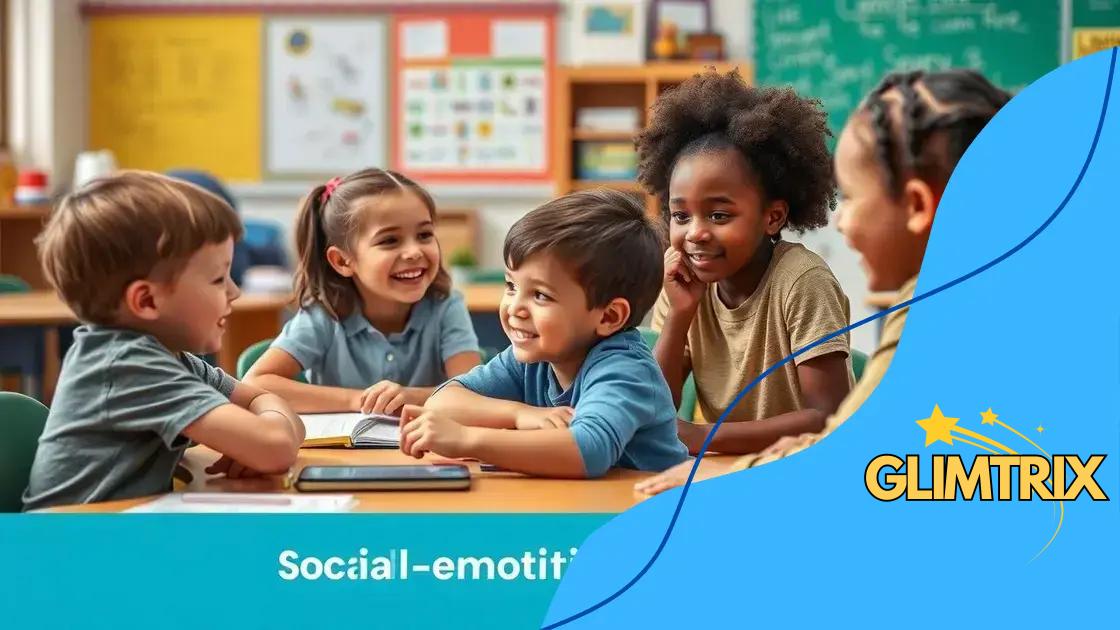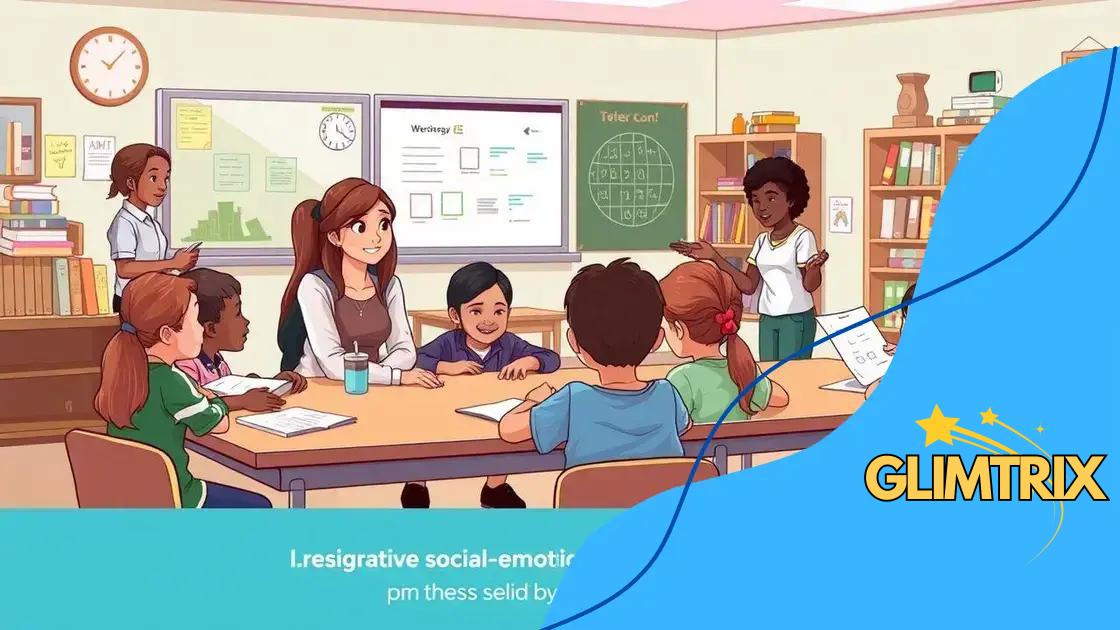Social-emotional learning curriculum development made easy

Social-emotional learning (SEL) implementation faces challenges such as resource limitations, resistance to change, diverse student needs, and the necessity for ongoing assessment to ensure its effectiveness in schools.
Social-emotional learning curriculum development is essential for fostering a supportive educational environment. By focusing on students’ emotional and social skills, we not only enhance their learning experience but also contribute to their overall well-being. Have you thought about how integrating SEL can transform your school’s approach?
Understanding social-emotional learning (SEL)
Understanding social-emotional learning (SEL) is vital for creating an enriching educational experience. SEL helps students develop essential skills like emotional awareness, relationship building, and effective decision-making. This learning approach does not just focus on academics but also nurtures the whole child.
What is SEL?
Social-emotional learning is a process through which children and adults understand and manage emotions, set goals, show empathy for others, establish positive relationships, and make responsible decisions. It is the foundation for positive development and lifelong success.
Key Components of SEL
There are five core competencies in SEL that define its practice:
- Self-Awareness: Recognizing emotions and values.
- Self-Management: Regulating emotions and behaviors effectively.
- Social Awareness: Understanding social norms and empathizing with others.
- Relationship Skills: Communicating clearly and resolving conflicts.
- Responsible Decision-Making: Making ethical, constructive choices.
While these components are distinct, they are interrelated and work together to influence a child’s development. For instance, when children develop better self-awareness, they tend to manage their emotions more effectively. This combination fosters a more positive classroom environment.
Benefits of Implementing SEL
Integrating SEL into educational settings provides numerous benefits that extend beyond school walls. Some advantages include:
- Enhanced academic performance through improved focus and engagement.
- Lower rates of bullying and behavioral issues.
- Increased emotional regulation and resilience in students.
In essence, understanding social-emotional learning (SEL) equips educators and students with the tools needed for a thriving educational journey. It allows students not only to excel academically but also to develop critical life skills that they will carry throughout their lives.
Key components of an effective SEL curriculum
Key components of an effective SEL curriculum are essential for successful implementation. When educators understand and utilize these components, they create an environment that supports students in developing vital emotional and social skills.
Five Core Competencies
An effective SEL curriculum is built around five core competencies:
- Self-Awareness: This involves recognizing one’s emotions, strengths, and values. It includes understanding how these affect behavior.
- Self-Management: Students learn to regulate their emotions, set goals, and demonstrate discipline. This ability is crucial for achieving personal and academic success.
- Social Awareness: This competency focuses on empathy and understanding social norms. Students learn to appreciate diversity and the perspectives of others.
- Relationship Skills: Building healthy relationships is vital. This component teaches students how to communicate clearly and maintain positive interactions.
- Responsible Decision-Making: Students are guided to make ethical and constructive choices. They learn to consider the well-being of themselves and others when making decisions.
Integrating these key components allows educators to address both emotional and academic needs. As each part interconnects, students develop holistically, preparing them for future challenges.
Practical Strategies for Implementation
To reinforce these competencies, educators can employ practical strategies. Here are a few:
- Incorporating role-playing scenarios to enhance social awareness.
- Using journaling to encourage self-reflection and boost self-awareness.
- Facilitating group discussions to practice relationship skills and develop empathy.
By consistently applying these strategies within the classroom, teachers help students grasp the significance of SEL, leading to positive outcomes both academically and personally.
Strategies for integrating SEL into existing programs

Strategies for integrating SEL into existing programs are crucial for maximizing the impact of social-emotional learning. By blending SEL with current educational frameworks, schools can enhance student outcomes and create a supportive learning environment.
Assessing Current Curriculum
The first step in integrating SEL is to assess your current curriculum. This involves identifying areas where social and emotional skills can be incorporated naturally. Look for opportunities in daily lessons or activities where SEL can complement the academic content.
Training Educators
Providing training for educators is essential. Professional development workshops can help teachers understand SEL principles and how to apply them effectively. This training should include:
- Strategies for fostering positive relationships in the classroom.
- Methods to teach emotional regulation and coping strategies.
- Techniques for creating a safe and inclusive classroom environment.
When teachers feel equipped to implement SEL, students benefit significantly from their guidance.
Incorporating SEL Activities
Incorporating specific activities focused on social-emotional skills is another effective strategy. Here are a few ideas:
- Conducting group discussions on emotions and behaviors.
- Using role-playing to practice conflict resolution.
- Implementing mindfulness exercises to enhance focus and emotional awareness.
These activities can be integrated into existing lessons without requiring a complete overhaul of the program. Consistency in practice reinforces the skills learned.
Engaging Families
Engaging families in the process of integrating SEL is also important. Educate parents on the value of social-emotional learning and suggest ways they can practice these skills at home. Providing resources or hosting informational workshops can strengthen the home-school connection.
Overall, integrating SEL into existing programs is not only feasible but also essential for creating a holistic educational experience.
Assessing the impact of SEL curriculum
Assessing the impact of a SEL curriculum is crucial to understanding its effectiveness in enhancing students’ social and emotional skills. This process involves various methods and metrics to gauge how well the curriculum meets its objectives.
Setting Clear Goals
Before assessment begins, it’s important to establish clear goals for the SEL curriculum. These goals should reflect what educators hope students will achieve, such as improved emotional regulation, better interpersonal skills, or increased empathy. Having specific objectives helps in measuring success.
Data Collection Methods
There are several effective methods to collect data on the impact of the SEL curriculum:
- Surveys and Questionnaires: These tools can gather student feedback on their feelings, behaviors, and experiences related to SEL.
- Observational Assessments: Teachers can observe student interactions and behaviors during SEL activities to evaluate engagement and skill application.
- Academic Performance Data: Comparing academic grades before and after implementing the SEL curriculum can provide insights into its influence on overall student performance.
Combining these methods helps create a comprehensive view of how well the SEL curriculum is functioning.
Analyzing Results
After collecting data, educators must analyze the results to determine whether the SEL curriculum met its goals. Look for trends in student progress, noting improvements in both social-emotional skills and academic outcomes. This analysis allows for informed decisions about continuing, adjusting, or expanding the program.
Continuous Improvement
Assessment should be an ongoing process, not a one-time event. By regularly evaluating the SEL curriculum, schools can make necessary adjustments to enhance its effectiveness. Feedback from students, parents, and teachers can guide these continuous improvements, ensuring that the curriculum remains relevant and impactful.
Challenges in social-emotional learning implementation
Challenges in social-emotional learning (SEL) implementation can hinder the effectiveness of programs designed to improve students’ emotional and social skills. Recognizing these challenges is essential for educators and administrators aiming to create a successful SEL environment.
Resource Limitations
One major challenge is often the lack of resources. Schools may not have enough funding to support proper training for educators or to purchase necessary materials. In many cases, schools struggle to allocate time within the curriculum for SEL activities. Without adequate resources, it can be hard to fully implement a comprehensive SEL program.
Resistance to Change
Another challenge is the resistance to change from educators and staff who are used to traditional teaching methods. Some may not understand the importance of SEL or may feel overwhelmed by incorporating it into their existing curriculum. Addressing this resistance through active engagement and training can help ease the transition.
Diverse Student Needs
Every student is unique, and addressing diverse emotional and social needs can be difficult. Teachers must be equipped to handle various challenges, such as differing cultural backgrounds and individual emotional issues. This complexity requires tailored approaches within the SEL framework to ensure that all students benefit equally.
- Individualized Support: Providing one-on-one support to students who may struggle with emotional challenges.
- Flexible Curriculum: Adapting SEL activities to fit the varied needs of the classroom.
- Family Engagement: Involving families in understanding SEL can improve consistency between home and school.
Additionally, there can be a lack of framework for assessing the effectiveness of the SEL programs. Without proper assessment, schools may struggle to identify whether their strategies are working and what adjustments need to be made.
Creating a Supportive Environment
Building a culture that values social-emotional learning is necessary for overcoming these challenges. This can be done by promoting teamwork among educators and encouraging open communication about SEL goals and experiences. Regular meetings can help foster a supportive community focused on enhancing students’ emotional growth.
FAQ – Frequently Asked Questions about Social-Emotional Learning (SEL)
What are the key components of an effective SEL curriculum?
The key components are self-awareness, self-management, social awareness, relationship skills, and responsible decision-making.
How can schools overcome resistance to SEL implementation?
Schools can provide training for educators and promote the benefits of SEL through workshops and discussions to ease resistance.
What challenges do diverse student needs present in SEL?
Diverse student needs require tailored approaches to ensure that all students can engage with and benefit from SEL programs.
Why is assessing the impact of SEL important?
Assessing the impact of SEL helps educators determine the effectiveness of programs and make necessary adjustments for better student outcomes.





